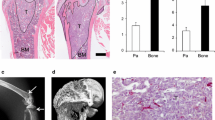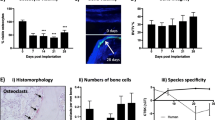Abstract
In practice, investigations for bone metastasis of breast cancer rely heavily on models in vivo. Lacking of such ideal model makes it difficult to study the whole process or accurate mechanism of each step of this metastatic disease. Development of xenograft mouse models has made great contributions in this area. Currently, the best animal model of breast cancer metastasizing to bone is NOD/SCID-hu models containing human bone, which makes it possible to let the breast cancer cells and the bone target of osteotropic metastasis be both of human origin. We have developed a novel mouse model containing both human bone and breast, and proved it functional and reliable. In this study, a set of human breast cancer cell line including MDA-MB-231, MDA-MB-231BO, MCF-7, ZR-75-1 and SUM1315 were characterized their osteotropism in this model. A specific cell line SUM1315 made species-specific bone metastasis, certifying the osteotropism-identification utility of the novel mouse model. Furthermore, gene expression and microRNA expression profiling analysis were done to the two SUM1315 derived sub lines isolated and purified from the orthotopic and metastatic xenograft. In addition, to demonstrate the disparity between the “spontaneous” and “forced” bone metastasis in mouse model, MDA-MB-231 cells were inoculated into both the human implants in this model simultaneously, and then primary cultured and profiling analyzed. Supported by overall results of profiling analyses, this study suggested the novel model was a useful tool for understanding, preventing and treating bone metastasis of breast cancer, meanwhile it had provided significant information for further investigations.


Similar content being viewed by others
References
Jemal A, Siegel R, Xu J, Ward E (2010) Cancer statistics, 2010. CA Cancer J Clin 60(5):277–300. doi:10.3322/caac.20073
Kiel KD (2004) Management of T1a breast cancer. Clin Breast Cancer 5(1):43–51
Roodman GD (2004) Mechanisms of bone metastasis. N Engl J Med 350(16):1655–1664. doi:10.1056/NEJMra030831
Coleman RE (2002) Future directions in the treatment and prevention of bone metastases. Am J Clin Oncol 25(6 Suppl 1):S32–S38
Mundy GR (2002) Metastasis to bone: causes, consequences and therapeutic opportunities. Nat Rev Cancer 2(8):584–593. doi:10.1038/nrc867
Costa L, Major PP (2009) Effect of bisphosphonates on pain and quality of life in patients with bone metastases. Nat Clin Pract Oncol 6(3):163–174. doi:10.1038/ncponc1323
Christofori G (2006) New signals from the invasive front. Nature 441(7092):444–450. doi:10.1038/nature04872
Kalluri R, Zeisberg M (2006) Fibroblasts in cancer. Nat Rev Cancer 6(5):392–401. doi:10.1038/nrc1877
Rodan GA (2003) The development and function of the skeleton and bone metastases. Cancer 97(3 Suppl):726–732. doi:10.1002/cncr.11147
Yoneda T, Hiraga T (2005) Crosstalk between cancer cells and bone microenvironment in bone metastasis. Biochem Biophys Res Commun 328(3):679–687. doi:10.1016/j.bbrc.2004.11.070
Goltzman D (2001) Osteolysis and cancer. J Clin Invest 107(10):1219–1220. doi:10.1172/JCI13073
Bauerle T, Adwan H, Kiessling F, Hilbig H, Armbruster FP, Berger MR (2005) Characterization of a rat model with site-specific bone metastasis induced by MDA-MB-231 breast cancer cells and its application to the effects of an antibody against bone sialoprotein. Int J Cancer 115(2):177–186. doi:10.1002/ijc.20840
Waltregny D, Bellahcene A, de Leval X, Florkin B, Weidle U, Castronovo V (2000) Increased expression of bone sialoprotein in bone metastases compared with visceral metastases in human breast and prostate cancers. J Bone Miner Res 15(5):834–843. doi:10.1359/jbmr.2000.15.5.834
Ibrahim T, Leong I, Sanchez-Sweatman O, Khokha R, Sodek J, Tenenbaum HC, Ganss B, Cheifetz S (2000) Expression of bone sialoprotein and osteopontin in breast cancer bone metastases. Clin Exp Metastasis 18(3):253–260
Arap W, Kolonin MG, Trepel M, Lahdenranta J, Cardo-Vila M, Giordano RJ, Mintz PJ, Ardelt PU, Yao VJ, Vidal CI, Chen L, Flamm A, Valtanen H, Weavind LM, Hicks ME, Pollock RE, Botz GH, Bucana CD, Koivunen E, Cahill D, Troncoso P, Baggerly KA, Pentz RD, Do KA, Logothetis CJ, Pasqualini R (2002) Steps toward mapping the human vasculature by phage display. Nat Med 8(2):121–127. doi:10.1038/nm0202-121
Kelland LR (2004) Of mice and men: values and liabilities of the athymic nude mouse model in anticancer drug development. Eur J Cancer 40(6):827–836. doi:10.1016/j.ejca.2003.11.028
Kamb A (2005) What’s wrong with our cancer models? Nat Rev Drug Discov 4(2):161–165. doi:10.1038/nrd1635
Kung AL (2007) Practices and pitfalls of mouse cancer models in drug discovery. Adv Cancer Res 96:191–212. doi:10.1016/S0065-230X(06)96007-2
Mbalaviele G, Dunstan CR, Sasaki A, Williams PJ, Mundy GR, Yoneda T (1996) E-cadherin expression in human breast cancer cells suppresses the development of osteolytic bone metastases in an experimental metastasis model. Cancer Res 56(17):4063–4070
Kang Y, Siegel PM, Shu W, Drobnjak M, Kakonen SM, Cordon-Cardo C, Guise TA, Massague J (2003) A multigenic program mediating breast cancer metastasis to bone. Cancer Cell 3(6):537–549
Nemeth JA, Harb JF, Barroso U Jr, He Z, Grignon DJ, Cher ML (1999) Severe combined immunodeficient-hu model of human prostate cancer metastasis to human bone. Cancer Res 59(8):1987–1993
Shtivelman E, Namikawa R (1995) Species-specific metastasis of human tumor cells in the severe combined immunodeficiency mouse engrafted with human tissue. Proc Natl Acad Sci USA 92(10):4661–4665
Yonou H, Yokose T, Kamijo T, Kanomata N, Hasebe T, Nagai K, Hatano T, Ogawa Y, Ochiai A (2001) Establishment of a novel species- and tissue-specific metastasis model of human prostate cancer in humanized non-obese diabetic/severe combined immunodeficient mice engrafted with human adult lung and bone. Cancer Res 61(5):2177–2182
Kuperwasser C, Dessain S, Bierbaum BE, Garnet D, Sperandio K, Gauvin GP, Naber SP, Weinberg RA, Rosenblatt M (2005) A mouse model of human breast cancer metastasis to human bone. Cancer Res 65(14):6130–6138. doi:10.1158/0008-5472.CAN-04-1408
Yang W, Lam P, Kitching R, Kahn HJ, Yee A, Aubin JE, Seth A (2007) Breast cancer metastasis in a human bone NOD/SCID mouse model. Cancer Biol Ther 6(8):1289–1294. doi:4504
Wang J, Xia TS, Liu XA, Ding Q, Du Q, Yin H, Wang S (2010) A novel orthotopic and metastatic mouse model of breast cancer in human mammary microenvironment. Breast Cancer Res Treat 120(2):337–344. doi:10.1007/s10549-009-0391-4
Xia TS, Wang J, Yin H, Ding Q, Zhang YF, Yang HW, Liu XA, Dong M, Du Q, Ling LJ, Zha XM, Fu W, Wang S (2010) Human tissue-specific microenvironment: an essential requirement for mouse models of breast cancer. Oncol Rep 24(1):203–211
Garcia T, Jackson A, Bachelier R, Clement-Lacroix P, Baron R, Clezardin P, Pujuguet P (2008) A convenient clinically relevant model of human breast cancer bone metastasis. Clin Exp Metastasis 25(1):33–42. doi:10.1007/s10585-007-9099-1
Pratap J, Wixted JJ, Gaur T, Zaidi SK, Dobson J, Gokul KD, Hussain S, van Wijnen AJ, Stein JL, Stein GS, Lian JB (2008) Runx2 transcriptional activation of Indian Hedgehog and a downstream bone metastatic pathway in breast cancer cells. Cancer Res 68(19):7795–7802. doi:10.1158/0008-5472.CAN-08-1078
Neudert M, Fischer C, Krempien B, Seibel MJ, Bauss F (2008) A rapid histological score for the semiquantitative assessment of bone metastases in experimental models of breast cancer. Onkologie 31(10):521–527. doi:10.1159/000151622
Sausville EA, Burger AM (2006) Contributions of human tumor xenografts to anticancer drug development. Cancer Res 66(7):3351–3354. doi:10.1158/0008-5472.CAN-05-3627 (discussion 3354)
Reddi AH, Roodman D, Freeman C, Mohla S (2003) Mechanisms of tumor metastasis to the bone: challenges and opportunities. J Bone Miner Res 18(2):190–194. doi:10.1359/jbmr.2003.18.2.190
Cailleau R, Young R, Olive M, Reeves WJ Jr (1974) Breast tumor cell lines from pleural effusions. J Natl Cancer Inst 53(3):661–674
Acknowledgments
We are grateful to Dr. Bei-Cheng Sun (Center of Liver Transplantation, the First Affiliated Hospital of Nanjing Medical University) for providing us with plenti-GFP lentivirus, to Stephen Ethier (University of Michigan) for providing us with SUM1315, to Dr. Jie Wang (Department of Medical Research, Guangzhou General Hospital of Guangzhou Command) for providing us with MDA-MB-231BO, and to Dr. Ji-Fu Wei (Clinical Experiment Center, the First Affiliated Hospital of Nanjing Medical University) for critical discussion in our study. This research was supported in part by the National Natural Science Foundation of China (81071753), the Six Kinds of Outstanding Talent Foundation of Jiangsu Province (06-B-069), and the Natural Science Foundation of Jiangsu Province (BK2008476, BK2009438 and BK2010581).
Conflict of interest
All the authors declared that they do not have any conflict of interest.
Author information
Authors and Affiliations
Corresponding author
Additional information
T.-S. Xia and G.-Z. Wang contributed equally.
Electronic supplementary material
Below is the link to the electronic supplementary material.
Online Resource 1
Material and method (DOC 43 kb)
Online Resource 2
Gene expression profiling of primary cultured cell lines and their parental lines (XLS 16564 kb)
Online Resource 3
Differentially expressed genes of primary cultured cell lines and their parental lines (XLS 31769 kb)
Online Resource 4
Raw intensity of miRNA in primary cultured cell lines and their parental lines (XLS 1463 kb)
Online Resource 5
miRNA expression profiling of primary cultured cell lines and their parental lines (XLS 1806 kb)
Online Resource 6
All differentially expressed miRNAs of primary cultured cell lines and their parental lines (XLS 155 kb)
Rights and permissions
About this article
Cite this article
Xia, TS., Wang, GZ., Ding, Q. et al. Bone metastasis in a novel breast cancer mouse model containing human breast and human bone. Breast Cancer Res Treat 132, 471–486 (2012). https://doi.org/10.1007/s10549-011-1496-0
Received:
Accepted:
Published:
Issue Date:
DOI: https://doi.org/10.1007/s10549-011-1496-0




